



Feed Outlook – November 2011
US feed grain production estimates have been lowered for 2011/12, according to Tom Capehart and Edward Allen in the latest report from the USDA Economic Research Service.Forecast corn yields are lowered 1.4 bushels per acre this month, trimming the 2011/12 production forecast by 123 million bushels to 12.3 billion. At 146.7 bushels per acre, this year’s yield would be the lowest since 2003/04. Sorghum and barley yields are increased by a half-bushel or less, while the oats yield slips slightly. The smaller corn crop and reductions in the outlook for broiler production result in a 100-million-bushel decline in projected corn feed and residual use. Projected ending stocks are reduced 23 million bushels and would be the lowest since 1995/96. Price prospects are lowered slightly for barley, but unchanged for the other feed grains. Increases in foreign coarse grain production and consumption mostly offset US reductions, leaving world totals little changed this month. Global 2011/12 coarse grain ending stocks are projected down slightly (0.6 per cent).
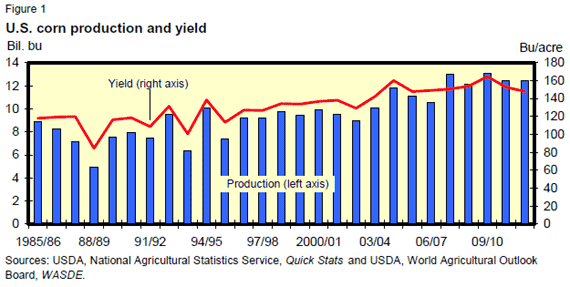
DOMESTIC OUTLOOK
Revised Yields Diminish Feed Grain Production Prospects for 2011/12
The November forecast for 2011/12 US feed grain production is 323.1 million tons, down from last month’s forecast of 326.2 million. The month-to-month decrease results from lower forecast corn production. Upward revisions for sorghum and barley and a slight decrease for oats, resulting from revised yields, are minimal. The feed grain supply change reflects adjustments in production as imports were steady for the four individual feed grains.
Domestic 2011/12 feed grain utilisation is projected at 290.4 million tons, down from 292.7 million last month and 7.2 million below last season. Feed and residual is lowered 2.5 million tons from last month due to tighter grain supplies and reduced poultry production prospects. Food, seed and industrial use (FSI) is raised 0.3 million tons to 169.4 million due to higher expected use of sorghum for ethanol production. Sorghum export prospects slip 0.3 million tons on the slow pace of sales and shipments to data. Forecast feed grain ending stocks are lowered 0.5 million tons as lower supplies are mostly offset by a decline in expected use. Price forecasts are unchanged for corn and sorghum but lowered for barley, with the projected ranges for both barley and oats narrowed.
Minor changes are made to the 2010/11 feed grains balance sheet reflecting updated data on FSI use and feed grain trade. Corn sweetener, starch, and ethanol production are all raised and imports are increased slightly while feed and residual use and exports slipped. Ending stocks estimates are unchanged.
Forecast Feed Use Lowered
On a September-August basis, 2011/12 feed and residual use for the four feed grains plus wheat is projected to total 127.2 million tons, 2.3 million below the adjusted total of 129.5 million for 2010/11. The share of corn as a proportion of feed and residual in 2011/12 was nearly same as in 2010/11 at 93 percent, with reduced corn feeding dominating an overall decline in feed and residual use.
The projected index of grain consuming animal units (GCAU) in 2011/12 is 93.3 million units, up from an adjusted 92.9 million units in 2010/11. Feed and residual per GCAU in 2011/12 is estimated at 1.36 tons, down from 1.39 in 2010/11. In the index components, GCAUs are increased this month for dairy cattle and turkeys, and reduced for cattle on feed, hogs and broilers.
Despite little change in feed grain prices this month, total US meat production is reduced from last month. Broiler production is forecast lower as sharper declines are expected in bird numbers during late 2011 and into 2012.
Beef production is reduced due to slightly lower cattle slaughter during the year and slower growth in carcass weights. USDA’s Cattle on Feed report on 19 October indicated cattle and calves on feed for slaughter in the United States (in feedlots with capacity of 1,000 or more head) totalled 11.3 million head on 1 October 2011. The inventory was five per cent above 1 October 2010. This is the second highest inventory on 1 October since the series began in 1996.
Placements in feedlots during September totalled 2.47 million head, slightly above 2010. Net placements were 2.40 million head. During September, placements of cattle and calves weighing less than 600 pounds were 685,000; 600-699 pounds were 415,000; 700-799 pounds were 504,000; and 800 pounds and greater were 865,000. On the trade side, beef export forecasts for 2011 and 2012 are raised slightly as strong global beef demand supports continued gains in US exports to a number of Asian markets. Continued strong demand for cattle in 2011 and 2012 is expected to support demand for feed despite higher grain prices.
Pork production is unchanged this month. USDA’s Livestock Slaughter report on 26 October indicated federally inspected average dressed weight of hogs at 270 pounds, unchanged from last year but slightly higher than August. Pork production is forecast higher in early 2012 compared with 2011, with higher hog numbers despite increased feed costs. Export markets have remained steady.
Milk production forecasts for 2011 and 2012 are unchanged from last month. On the trade side, exports are forecast up in 2011 and unchanged in 2012 due to continued global economic recovery and favourable exchange rates. Nevertheless, higher feed prices and lower forecast milk prices in 2012 are expected to limit the rate of growth and the amount of feed used for dairy production.
Broiler hatchery data from USDA’s Broiler Hatchery report of 26 October points toward a reduction in broiler production as the number of broiler-type eggs set is down eight per cent and broiler-type chicks placed is down six per cent from the comparable week a year earlier. In addition, USDA’s Poultry Slaughter report of 25 October shows September broiler production down four per cent from last year’s comparable week and six per cent from August, supporting lower production forecasts for 2011 and 2012. High feed costs continue to squeeze margins for poultry producers, resulting in contraction in the broiler sector.
USDA’s Chicken and Eggs report of 22 October showed all layers on 1 October were down slightly from a year earlier. US egg production was also down slightly. Pullets added to the layers-on-hand flock during September were up slightly from a year earlier. Egg-type chicks hatched during September 2011 were up slightly for the month while broiler-type chicks hatched were down five per cent for the month and eight per cent from a year earlier. Reduced egg production and broiler hatch is the result of high feed prices and is likely to continue into 2012.
USDA’s Turkey Hatchery report of 15 October indicated that eggs in incubators on 1 October were up five per cent from a year earlier but down two per cent from the previous month. Turkey poults hatched and net poults placed during September were up eight per cent each from the same month last year. The Poultry Slaughter report also showed a two-per cent increase in live weight from a year earlier. Turkey production for 2011 and 2012 is forecast higher this month. With more eggs in incubators than a year ago and increases in both poults hatched and placed, feed use is expected to increase despite rising costs as producers replenish flocks after reductions in previous years.

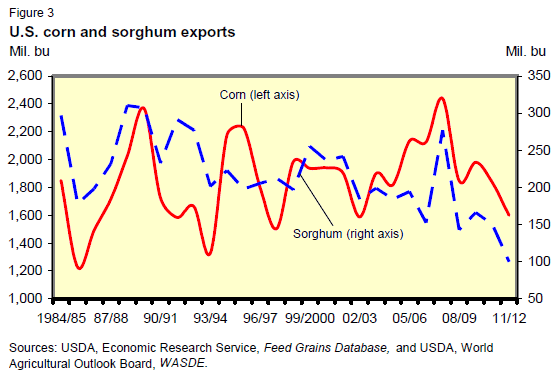
Minor Changes Made to 2010/11 Marketing Year
The November estimate of 2010/11 food, seed and industrial use for corn is raised 12.3 million bushels from last month to 6,428 million bushels on adjustments resulting from fourth-quarter updates for some FSI categories and final EIA ethanol production data. High-fructose corn syrup (HFCS) and starch uses are raised, along with glucose and dextrose uses. Ethanol use is raised slightly. Feed and residual use for corn is lowered 11.2 million bushels to 4,792 million, reflecting higher FSI use and minor adjustments to trade.
Exports are lowered 0.472 million bushels to 1,835 million. Imports are raised 0.668 million bushels to 28 million based on August trade data from the US Census Bureau.
2011/2012 Corn Crop Forecast Lowered
The Crop Production report of 9 November forecast US corn production for 2011/12 at 12.310 billion bushels, down 123 million from the October forecast. At this volume, it would be the fourth largest crop on record. Based on conditions as of 1 November, yields are expected to average 146.7 bushels per acre, compared with 148.1 bushels per acre forecast in October and 152.8 bushels per acre estimated for 2010/11.
Beginning stocks and imports are unchanged this month, resulting in total supply of 13,453 million bushels, 123 million below last month’s forecast. The corn objective yield data on 1 November indicate higher yields for Iowa and Ohio but reductions for a number of major corn-producing States, including Illinois, Minnesota, the Dakotas and Kansas.
Feed and residual use is projected 100 million bushels lower on the smaller crop and lower expected meat production, driven by reduced prospects for broilers. FSI use is unchanged at 6,410 million bushels. Corn export prospects are unchanged this month as large current outstanding sales are offset by expected stiff competition in coming months from large foreign grain supplies.
Forecast corn ending stocks for 2011/12 are reduced 23 million bushels from October as reductions in supply exceed reductions in use. At 843 million bushels, ending stocks would be the lowest since 1995/96 and represent a carryout of 6.7 per cent of expected total use. In 1995/96, carryout dropped to five per cent of expected use. The projected season-average price range is unchanged at $6.20 to $7.20 per bushel.
Sorghum Yields Edge Up
The Crop Production report of 9 November raises the 2011 forecast sorghum yield 0.5 bushel per acre to 55.5 bushels. Production is forecast 2.1 million bushels higher at 246 million bushels, mostly due to an upward revision for Texas. Forecast 2011/12 ending stocks are raised 2.1 million bushels to 28 million as a result.
Shifts Within Sorghum Use for 2011/12
Forecast 2011/12 sorghum FSI use is increased 10 million bushels this month to 90 million bushels on higher expected use for ethanol. Exports are lowered 10 million bushels, resulting in no change in total use or carry-out.
For the 2010/11 marketing year, a 0.357-million-bushel increase in exports was offset by a 0.357-million-bushel decrease in feed and residual use, leaving estimated total use unchanged from last month. The sorghum farm price projection is unchanged at $6.00 to $7.00 per bushel.
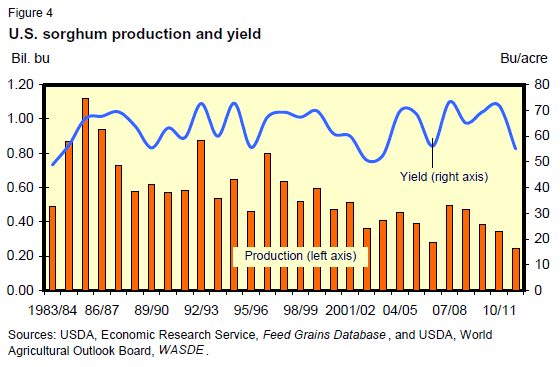

Barley Yield Raised, Oats Lowered
The Crop Production report of 9 November revises the 2011 barley yield up 0.4 bushel per acre based on a resurvey of States that had significant unharvested spring grains as of early September when surveys were completed for the Small Grains report on 30 September. Barley production is raised 0.7 million bushels to 156 million. The objective yield for 2011 oats was also revised in the November Crop Production report, lowering the estimated yield 0.4 bushel per acre. Oats production for 2011/12 is reduced 0.4 million bushels to 54 million, a record low.
Barley Price Reduced
November’s forecast for 2011/12 barley prices received by farmers is forecast at $5.35 to $6.05 per bushel, reduced 10 cents at the low end of the range and 25 cents at the high end compared with October’s forecast. The forecast oats price, at $3.15 to $3.65 per bushel, is reduced 5 cents at the high end of the range and increased 5 cents at the low end compared with October, leaving the midpoint unchanged.
INTERNATIONAL OUTLOOK
Global Coarse Grain Production Little Changed This Month
World coarse grain production is projected to reach 1,135.8 million tons in 2011/12, down slightly this month as the US reduction mostly offsets an increase in foreign countries. Foreign corn production is up 2.0 million tons to 546.3 million as large increases for China, the EU and Argentina are partly offset by a sharp reduction in prospects for Mexico with numerous other changes, especially for countries in Africa. Foreign barley production is up 0.6 million tons to 129.8 million with increased production for the EU and Kazakhstan. However, EU changes are reducing foreign rye production 0.6 million tons to 12.6 million but boosting foreign oats and mixed grain production by 0.2 million and 0.1 million tons, respectively, to 21.9 million and 15.2 million tons. Changes to forecast 2011/12 millet production are mostly small and offsetting, but numerous sorghum changes boost foreign production 0.3 million tons to 54.7 million.
The largest change in 2011/12 corn production prospects this month is for Mexico, down 3.5 million tons to 20.5 million. Mexico’s main-season corn crop accounts for about three-quarters of the crop, with production on the Central Plateau in States surrounding Mexico City having an important share. In this region, spring rains were delayed and part of the crop was planted late. Then in early September, a very unusual freeze damaged some corn that was still in grain fill. Harvest reports are verifying that corn yields for the main corn crop are not as good as earlier projected. Moreover, there is an important irrigation water supply problem developing for the winter corn crop concentrated in Sinaloa. The previous year’s corn crop in Sinaloa was devastated by a February 2011 freeze early in the growing season. Significant replanting of corn occurred, extending the use of irrigation water, and the successful replanting is contributing to a 0.5-million-ton increase this month in the 2010/11 corn production estimate to 21.1 million tons. However, the summer rainy season in the mountains near Sinaloa had below-normal precipitation. The combination of extended use of irrigation supplies into the spring and summer of 2011 and the poor rains has left reservoirs without enough water for normal winter irrigation and other uses. This seriously compromises area and yield prospects for the 2011/12 winter corn crop.
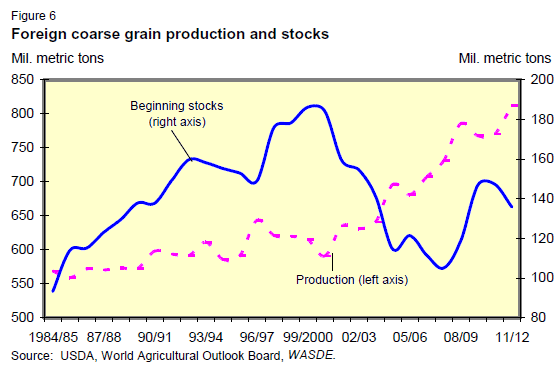
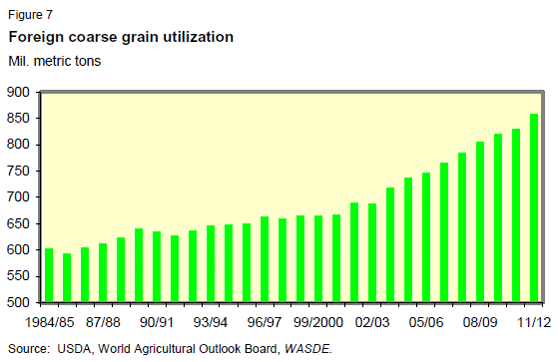
China’s corn production for 2011/12 is projected to reach a record 184.5 million tons, up 2.5 million this month. Chinese sources are reporting significantly increased corn area in Heilongjiang and Inner Mongolia. Growing conditions have been favourable across most of China and harvest reports indicate a bumper crop. A balance of increased area and yield support the higher production.
EU corn production for 2011/12 is increased 1.9 million tons this month to 62.9 million. France reported sharply higher yields, boosting production 1.0 million tons. Significantly increased corn production, based on harvest reports, was also reported for Romania and Austria, with small changes for several other countries.
In Argentina, some corn is still being planted, and attractive corn prices are drawing in more area than earlier expected. Projected harvested area is increased six per cent this month to 3.8 million hectares, boosting production 1.5 million tons to 29.0 million.
Corn production in Sub-Saharan Africa was reviewed in detail this month, resulting in a reduction in corn production prospects for 2011/12 of 0.6 million tons to 55.6 million, still a record large corn crop. Rains across much of the region were about normal but below the previous year’s abundant rainfall. Corn area has increased for 2011/12 compared to the previous year, more than offsetting a yield slightly below last year’s record. The largest adjustment in projected 2011/12 production is for Cameroon, down 0.6 million tons to 1.2 million with significantly reduced area as well as yield. Good yields are reported for Malawi, boosting corn production 0.4 million tons to 3.9 million but disappointing yields trimmed prospects for Tanzania 0.3 million to 3.3 million. Other countries (in order by size of production change) in the region with corn production increases are Mozambique, Angola, Rwanda, Central African Republic, Swaziland and Burundi while reductions are forecast for Senegal, Ghana, Uganda, Lesotho, Mali, Madagascar, Somalia and Mauritania.
Serbia’s corn production is reduced 0.4 million tons to 6.3 million as harvest reports indicate that dryness during the growing season reduced both area harvested for grain and the grain yield. However, harvest reports in Belarus and Russia reveal better-than-expected yields, boosting production 0.4 million tons to 1.6 million for Belarus and 0.3 million to 6.3 million for Russia.
EU 2011/12 barley production is up 0.5 million tons this month to 52.4 million, with increased yields more than offsetting a reduction in area. Increases for the UK, Czech Republic and Austria more than offset reductions reported for Spain and Poland. Kazakhstan reported good grain yields, boosting barley production 0.2 million tons to 2.5 million. For South Africa, barley yield prospects are favourable, offsetting reduced area and increasing production prospects slightly. However, Algeria reported barley yields lower, reducing production 0.2 million tons to 1.4 million.
Argentina reports area planted to sorghum exceeding earlier expectations, boosting production prospects 0.7 million tons to 4.7 million. Strong global feed grain prices, less government intervention in sorghum exports compared to corn, and producers’ concerns about the possibility of dryness associated with a La Ninña weather pattern, tend to support sorghum planting. However, for Mexico, dryness is expected to trim sorghum area, reducing production 0.2 million tons to 6.6 million. There are also small reductions in sorghum area and production this month for the EU.
Sorghum production for Sub-Saharan Africa is reduced 0.2 million tons this month to 27.1 million as numerous changes are nearly offsetting. The largest production change is for Sudan, down 0.4 million tons to 3.8 million due to reduced area. There are also reductions for Nigeria, Tanzania, Mali, Somalia, Zimbabwe, Ghana, Lesotho, Rwanda and Mauritania but increases for Cameroon, Ethiopia, Mozambique, Kenya, Togo and Burundi.
Foreign coarse grain beginning stocks for 2011/12 are down slightly this month to 135.8 million tons as changes are mostly offsetting. The largest change is for Mexico, up 0.9 million tons to 2.7 million based on increased sorghum and corn production estimated for 2010/11. However, Brazil and South Africa each have beginning stocks reduced 0.5 million tons this month because of increased corn exports estimated for 2010/11. Changes to estimated 2010/11 supply and demand boosted 2011/12 beginning stocks by small amounts (in descending order) for Nigeria, Japan, Tanzania, Tunisia, Ethiopia, India, China, Somalia, Mozambique and Kenya; but reduced them for Cameroon, Niger, Uruguay, Uganda, Russia, Sudan, Australia, Angola, Belarus, the EU, Senegal, South Korea and Madagascar.
Increased Foreign Coarse Grain Use Projected for 2011/12
Global coarse grain use in 2011/12 is projected up 0.3 million tons this month to 1.149 billion tons as increased foreign use offsets the US reduction. Foreign use is up 2.6 million tons to a record 858.1 million. This is a 3.4-per cent increase over the previous year despite high prevailing prices, indicating strong demand, partly to support expanding meat production in many countries.
The largest increase in projected coarse grains use this month is for China, up 2.5 million tons to 197.3 million. Supplies are expanding in China, with increased corn production and imports this month but prices remain strong amid booming demand. Food, seed and industrial use of corn is increased 2.0 million tons this month to 57.0 million, as industrial use is reported to be expanding rapidly. Feed seed and waste for corn is increased 0.5 million tons this month to 132.0 million as meat production is also growing.
EU 2011/12 coarse grain use is forecast up 1.3 million tons to 147.6 million. Poultry meat production expansion, though modest, is supporting feed demand. With increased production, corn feed use is up 2.0 million tons to 64.5 million but reduced rye production is reducing total use 0.5 million tons to 7.3 million. Barley feed use is reduced 0.5 million tons to 37.0 million as exports are bidding barley away from EU domestic use. EU oats use is up 0.2 million tons this month but sorghum feeding is projected down slightly.
Mexico, with sharply lower production prospects this month, is projected to use 40.4 million tons of coarse grains, down 1.5 million, with almost the entire drop in feed use. There is an increase of 0.3 million tons in feed use of sorghum but a drop of 1.7 million tons in corn feeding.
South Sudan is added to the USDA data base this month, with a coarse grain total use of 0.6 million tons, mostly sorghum. However, Sudan’s sorghum use is reduced 0.4 million this month. For the entire region of Sub-Saharan Africa, coarse grain use is reduced 0.9 million tons to 101.6 million mostly due to lower production prospects. The largest decline is for Cameroon, down 0.5 million tons to 1.9 million.
Argentina, with increased production of corn and sorghum this month and an expanding poultry sector, is projected to have coarse grain use up 0.3 million tons to 11.7 million. South Korea’s corn feed use is up 0.3 million tons this month as recent purchases have leaned more toward corn and less to feed-quality wheat than previously expected. The historical supply and use for Uruguay is revised this month lowering projected corn feed 0.3 million tons to 0.8 million. There are smaller increases this month projected for coarse grain use in Australia, Jordan, Russia, Tunisia, Kazakhstan, Algeria, Saudi Arabia and Belarus.
Global Coarse Grain Ending Stocks Projected Slightly Lower This Month
World 2011/12 coarse grain ending stocks are projected down 0.9 million tons this month to 155.1 million, with the decline in foreign stocks smaller than the US reduction. Foreign stocks are down 0.3 million tons to 131.2 million, with several significant changes mostly offsetting. The largest change is a projected increase in coarse grain stocks for Argentina, up 1.1 million tons to 3.8 million due to sharply increased production prospects. China, with increased corn production and imports, is expected to have ending stocks of coarse grain 1.0 million tons higher at 52.4 million. There are also small increases in projected coarse grain ending stocks for Belarus, Japan, Saudi Arabia, Tunisia, India and Kazakhstan.
EU coarse grain ending stocks for 2011/12 are reduced 0.7 million tons this month to 12.7 million. Increased production is being more than offset by domestic use, reduced imports and increased exports. Mexico’s ending stocks are projected down 0.7 million tons to 2.2 million, due to lower production. The Sub-Saharan Africa region is forecast to carry coarse grain stocks 0.5 million tons lower at 10.0 million as reduced production trims stocks. Brazil’s 2011/12 ending stocks are projected down 0.5 million tons to 10.7 million as beginning stocks are reduced by strong 2010/11 exports. Smaller reductions are forecast for Serbia, Australia, Russia, Uruguay and South Korea.
World Coarse Grain Trade Increased; US Corn Prospects Unchanged
Global 2011/12 (October-September) coarse grain trade is increased 1.5 million tons this month to 118.5 million. Corn trade is increased 1.0 million tons to 94.4 million, and barley trade is increased 0.5 million tons to 15.9 million.
Corn imports by China are raised 1.0 million tons to 3.0 million due to significant purchases from the United States. Corn prices in China are high enough to cover the cost and transport of US corn to China. Most of the purchases are being made by government enterprises that use corn to maintain stocks that can be auctioned into the market to keep a lid on domestic prices.
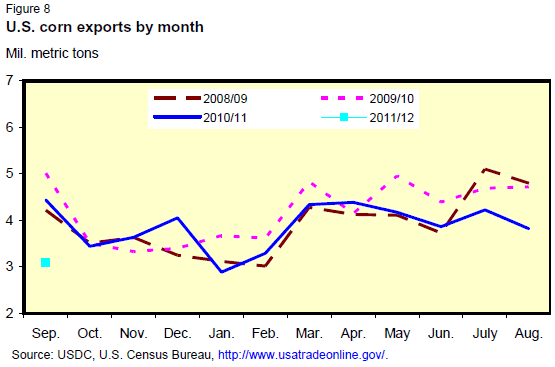
Mexico’s corn imports are raised 0.6 million tons to 9.8 million due to reduced production prospects. South Korea’s corn imports are boosted 0.3 million tons to 8.0 million as corn has been more competitive with feed quality wheat in that market than earlier expected. There are smaller increases in forecast corn imports for Kenya, Tunisia, Jordan and Lesotho.
EU corn exports are reduced 0.5 million tons to 3.5 million as increased production limits the need to import. For Uruguay, import prospects are reduced 0.35 million tons to 0.05 million in line with historical revisions that take out transshipments.
Corn exports for Argentina in 2011/12 (October-September) are increased 0.5 million tons to 18.5 million, supported by increased production prospects. The new-crop corn will be available only during the second half of the trade year, limiting the increase. EU corn export prospects are raised 0.5 million tons to 2.0 million. Increased production generally, and large corn supplies in EU countries near the Black Sea are expected to encourage exports outside the EU. The strong early pace of export licences also supports increased corn exports. Belarus, with a large crop, is forecast to export 0.2 million tons of corn in 2011/12, up 0.1 million this month. Tanzania’s corn exports are increased slightly as shipments are expected to neighbouring countries with reduced production prospects. These increases are partly offset by a 0.1-million-ton reduction in export prospects for Serbia, due to reduced production.
US corn exports for 2011/12 remain projected at 41.0 million tons – 1.6 billion bushels for the September-August local marketing year – down from 45.3 million for the previous year. Export inspections data for October indicate shipments slower than a year earlier, but outstanding export sales at the beginning of November were 15.0 million tons, up 2.4 million tons from a year ago. Future sales of US corn are expected to be limited by high US prices and strong competition from foreign grain.
US sorghum exports for 2011/12 are forecast down 0.3 million tons this month to 2.4 million – down 10 million bushels to 90 million for the September-August local marketing year. The pace of sales and shipments has been slow, and future export sales are expected to be limited by tight US supplies and stronger domestic demand. Argentina’s sorghum exports are forecast up 0.3 million tons this month to 2.3 million with increased production.
Global 2011/12 barley trade is boosted by an increased imports forecast this month for Saudi Arabia and Algeria, with increased exports for the EU. The pace of EU export licences indicates that barley exports are lucrative enough to bid barley away from the domestic market.
Further Reading
| - | You can view the full report by clicking here. |
November 2011








